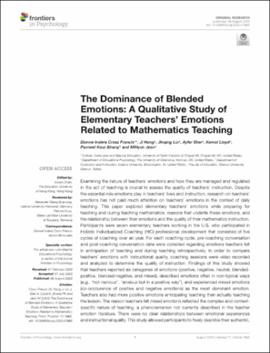| dc.contributor.author | Francis, Dionne Indera Cross | |
| dc.contributor.author | Hong, Ji | |
| dc.contributor.author | Liu, Jinqing | |
| dc.contributor.author | Eker, Ayfer | |
| dc.contributor.author | Lloyd, Kemol | |
| dc.contributor.author | Bharaj, Pavneet Kaur | |
| dc.contributor.author | Jeon, MiHyun | |
| dc.date.accessioned | 2020-10-14T14:29:54Z | |
| dc.date.available | 2020-10-14T14:29:54Z | |
| dc.date.issued | 2020-08-06 | |
| dc.identifier.citation | Cross Francis DI, Hong J, Liu J, Eker A, Lloyd K, Bharaj PK and Jeon M (2020) The Dominance of Blended Emotions: A Qualitative Study of Elementary Teachers’ Emotions Related to Mathematics Teaching. Front. Psychol. 11:1865. doi: 10.3389/fpsyg.2020.01865 | en_US |
| dc.identifier.uri | https://hdl.handle.net/11244/325605 | |
| dc.description.abstract | Examining the nature of teachers’ emotions and how they are managed and regulated in the act of teaching is crucial to assess the quality of teachers’ instruction. Despite the essential role emotions play in teachers’ lives and instruction, research on teachers’ emotions has not paid much attention on teachers’ emotions in the context of daily teaching. This paper explored elementary teachers’ emotions while preparing for teaching and during teaching mathematics, reasons that underlie these emotions, and the relationship between their emotions and the quality of their mathematics instruction. Participants were seven elementary teachers working in the U.S. who participated in Holistic Individualized Coaching (HIC) professional development that consisted of five cycles of coaching over an year. For each coaching cycle, pre-coaching conversation and post-coaching conversation data were collected regarding emotions teachers felt in anticipation of teaching and during teaching retrospectively. In order to compare teachers’ emotions with instructional quality, coaching sessions were video recorded and analyzed to determine the quality of instruction. Findings of this study showed that teachers reported six categories of emotions (positive, negative, neutral, blended-positive, blended-negative, and mixed), described emotions often in non-typical ways (e.g., “not nervous”, “anxious but in a positive way”), and experienced mixed emotions (co-occurrence of positive and negative emotions) as the most dominant emotion. Teachers also had more positive emotions anticipating teaching than actually teaching the lesson. The reason teachers felt mixed emotions reflected the complex and context-specific nature of teaching, a phenomenon not currently described in the teacher emotion literature. There were no clear relationships between emotional experiences and instructional quality. This study allowed participants to freely describe their authentic, complex, overlapping, and ambiguous emotions in the context of active teaching, which contributes opening up the possibilities of diversifying teacher emotion research and shows the significance and usefulness of understanding teachers’ emotions related to active instruction. | en_US |
| dc.description.sponsorship | This work was supported by funds received from Improving Teacher Quality Grant, U.S. Department of Education Award # J22-16-C0462.
Open Access fees paid for in whole or in part by the University of Oklahoma Libraries | en_US |
| dc.language | en_US | en_US |
| dc.rights | Attribution 4.0 International | * |
| dc.rights.uri | https://creativecommons.org/licenses/by/4.0/ | * |
| dc.subject | Mixed Emotions | en_US |
| dc.subject | Mathematics Teacher Emotions | en_US |
| dc.subject | Teacher Emotions | en_US |
| dc.subject | Mathematics Teacher Quality | en_US |
| dc.subject | Teaching Quality | en_US |
| dc.subject | Blended Emotions | en_US |
| dc.subject | Emotion Blends | en_US |
| dc.title | The Dominance of Blended Emotions: A Qualitative Study of Elementary Teachers’ Emotions Related to Mathematics Teaching | en_US |
| dc.type | Article | en_US |
| dc.description.peerreview | Yes | en_US |
| dc.identifier.doi | 10.3389/fpsyg.2020.01865 | en_US |
| ou.group | College of Arts and Sciences::Department of Psychology | en_US |

